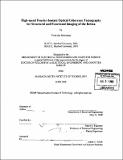High-speed Fourier domain Optical Coherence Tomography for structural and functional imaging of the retina
Author(s)
Srinivasan, Vivek Jay
DownloadFull printable version (77.69Mb)
Alternative title
High-speed Fourier domain OCT for structural and functional imaging of the retina
Other Contributors
Massachusetts Institute of Technology. Dept. of Electrical Engineering and Computer Science.
Advisor
James G. Fujimoto.
Terms of use
Metadata
Show full item recordAbstract
Optical Coherence Tomography (OCT) is an emerging optical biomedical imaging technology that enables cross-sectional imaging of scattering tissue with high sensitivity and micron-scale resolution. In conventional OCT, the reference arm path length in a Michelson interferometer is scanned in time to generate a profile of backscattering versus depth from the sample arm. In conventional OCT, a broadband, low coherence light source is used to achieve high axial resolution. However, clinical and research applications of conventional OCT have been limited by low imaging speeds. Recently, new Fourier domain OCT detection methods have enabled speeds of ~20,000-40,000 axial scans per second, which are ~50-100x faster than conventional OCT. These methods are called "Fourier domain" because they detect the interference spectrum and do not require mechanical scanning of the reference arm path length in time. In this thesis, two different technologies for Fourier domain OCT are investigated. The first technology, called spectral OCT, uses a broadband light source and a spectrometer to measure the interference spectrum. The second technology, called swept source OCT, uses a rapidly tunable narrowband laser to measure the interference spectrum over time. Applications of these new technologies for retinal imaging are illustrated, including three-dimensional retinal imaging in animal models, clinical imaging of retinal pathologies, quantification of photoreceptor morphology, and functional imaging of intrinsic stimulus-induced scattering changes in the retina. Finally, using a rapidly tunable laser, ultrahigh-speed swept source OCT imaging at 249,000 axial scans per second, roughly three orders of magnitude faster than conventional OCT, is demonstrated. This technology is applied for three-dimensional snapshots of the retina and optic nerve head and unprecedented visualization of retinal anatomy.
Description
Thesis (Ph. D.)--Massachusetts Institute of Technology, Dept. of Electrical Engineering and Computer Science, 2008. Includes bibliographical references.
Date issued
2008Department
Massachusetts Institute of Technology. Department of Electrical Engineering and Computer SciencePublisher
Massachusetts Institute of Technology
Keywords
Electrical Engineering and Computer Science.